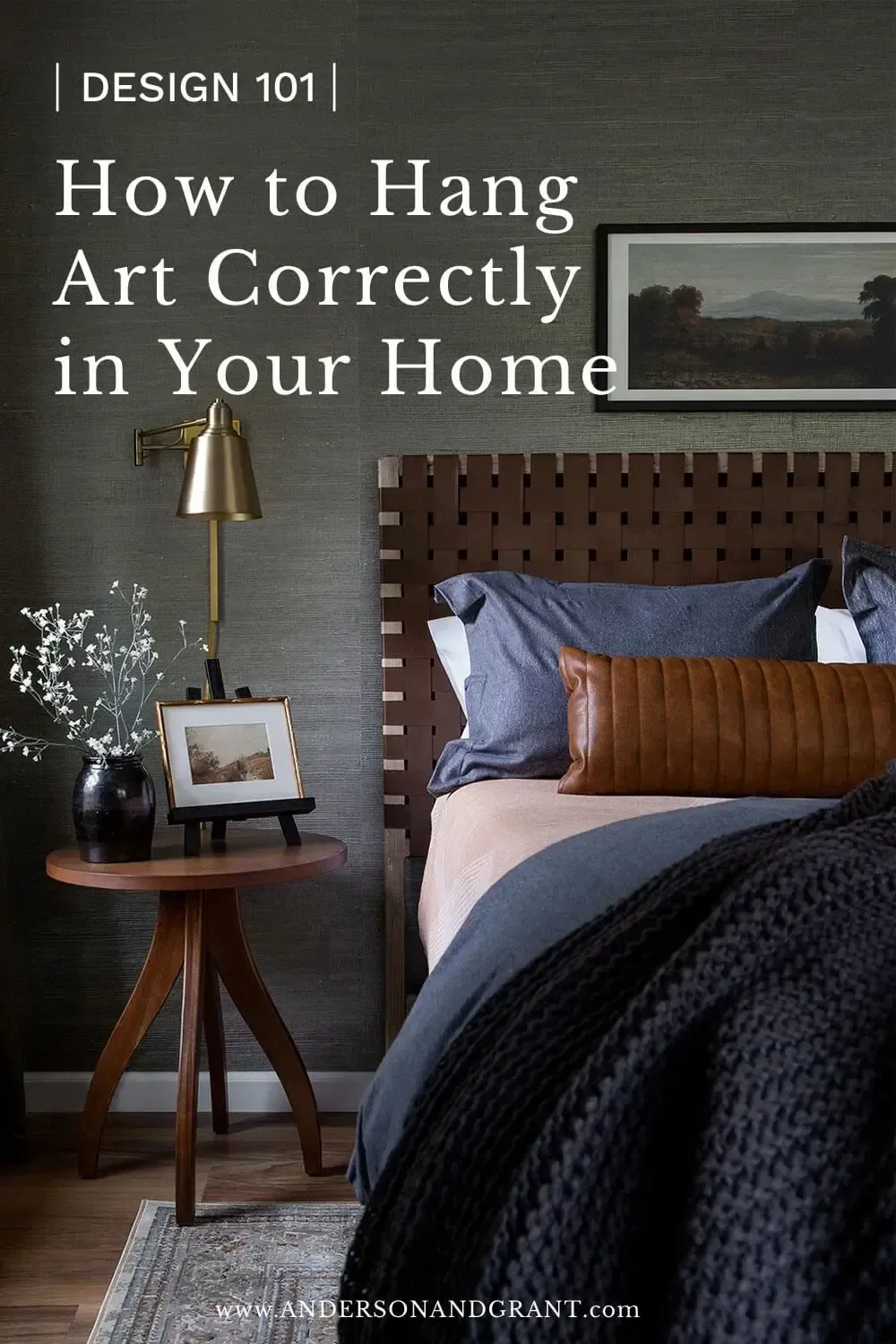Ever wonder how high your artwork should hang on the wall? Or how large a piece you should buy for over a sofa? This post breaks down all the specifics you should know about heights, sizes, orientations, and placement along with plenty of inspiration that will have you picking up a hammer to add some frames to your own walls.
DESIGN + STYLE | Updated January 18, 2024
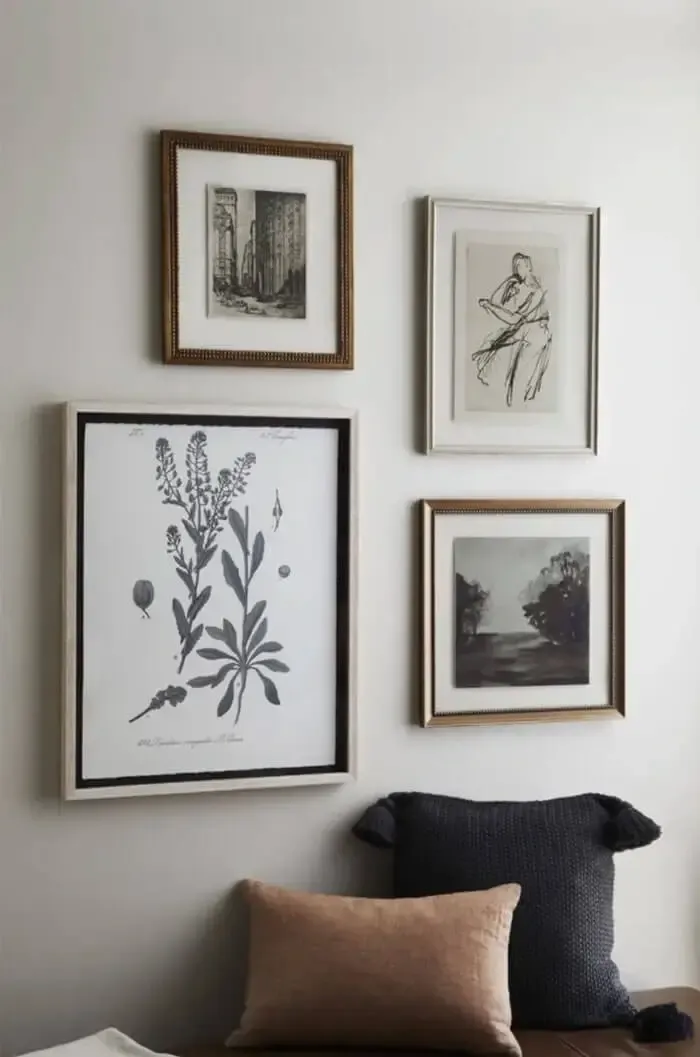
The hardest part of adding artwork to your home isn't shopping for art you love, but rather determining the proper way to hang it.
There are countless options for artwork - every style, size, shape, color palette, and orientation you could ask for. And you generally know when looking at a piece whether or not you like it and and if it will visually fit into your house.
But it is the next step after you bring it home that becomes daunting.....the actual placement on the wall.
When hung at the proper height and in proper scale to the room and furnishings around it, artwork enhances a room and brings everything together. Here are a few guidelines to make shopping for the right size and orientation of artwork easier, as well as how to determine its proper placement on your walls.
**While this post talks specifically about art, these tips apply whether you are hanging framed or unframed artwork, photographs, mixed gallery walls, decorative mirrors, or decor in groupings such as baskets or plates.

HELPFUL TIPS FOR HANGING ARTWORK CORRECTLY
How High Should You Hang Artwork?
When hanging pictures and art on the wall, people tend to hang it too high. Framed prints should be placed in close proximity to furniture so that everything reads as one cohesive unit and low enough on the wall to view comfortably when sitting or standing.
PROPER HEIGHT
The general rule of thumb is for your artwork to be hanging at eye level or slightly lower on an unobstructed wall. This means that the center of your artwork should rest between 57 and 60 inches from the floor (with your hook measuring higher than that based on the location of your hardware).
- Aim for the lower height of 57 inches in rooms where people spend time sitting, ceilings are low (8 foot or less), or if your family is on the short side.
- The upper height of 60 inches is best in rooms where the ceilings are high, your family is on the taller side, or when the height just looks better to your naked eye.
To figure out where to place your picture hanging hook or nail:
STEP 1: Determine the height that you want the center of your frame to rest at (ideally 57-60 inches).
STEP 2: Measure the height of your frame and divide it by two to find the center.
STEP 3: Measure from the top of the frame to the top of your tightened picture hanging wire or hook it will hang from. Subtract this number from your center frame measurement in step 2. This tells you how far above the picture's center point your hook should go.
STEP 4: Take the measurement from step three and add it to the height you determined in step 1. This is how high up to measure from the floor to install your hook or nail.
Example: You want your picture to hang 57 inches from the floor. Your frame is 20 inches tall, so the center would be 10 inches. The top of the wire is 2 inches below the top of the frame, so 10-2=8. Add 8 +57=65. Your hook should be 65 inches from the floor.
When hanging artwork over furniture, aim for a space of 6 to 8 inches between the bottom of the frame and furniture. This applies to sofas, consoles, sideboards, dressers, or any kind of table or stand.
Art and furniture should be close enough together that they appear as one unit. If there is a large gap or if one piece is out of proportion with the other, they will seem disjointed and the art will look like it is floating on its own.
If the furniture is really low, consider hanging the art on the lower end to connect the pieces. And if your ceiling are really high, you can hang artwork between 10 to 12 inches above the furniture to fill the wall space.
If you are hanging two (or more than two) pieces together as one, the center of your grouping should still be 57 - 60 inches from the floor. This is true for art that is hung vertically, horizontally, or in a grid. It is fine if the 60 inch center mark ends up in the space between two frames.
When hanging a row of different sized artwork, align each piece so their center point is the same, rather than aligning them by their tops or bottoms.
For eclectic gallery walls, hang your anchor piece at the correct height and build from there.It is difficult to know how to place things correctly when dealing with different sizes, orientations, and shapes. But if you choose your most prominent piece first, hanging it at the appropriate height, you can spread the rest of the collection around it in a pleasing layout.
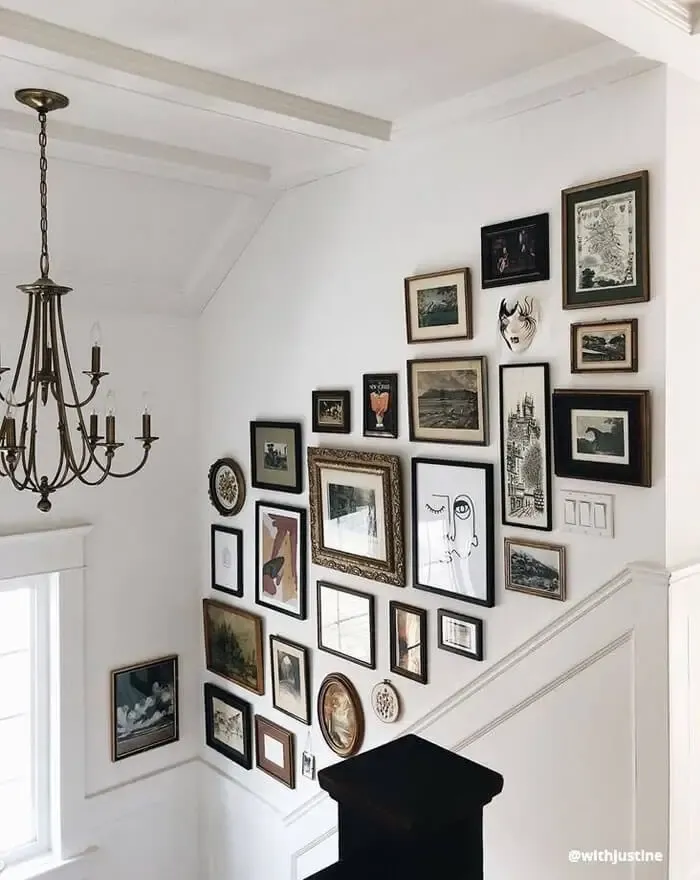
With Justine @withjustine
Use a variety of frames in different finishes, sizes, and shapes, but keep it looking cohesive with a neutral palette of prints and artwork like Justine did up her staircase wall. On the flip side, use similar colors of frames and mats to unite artwork in different tones.
SPECIFIC MEASUREMENTS
Be consistent when hanging artwork in your home, as it creates flow and harmony among your decor when things are hanging at the the same heights. For example, art hanging in rooms where you do a lot of standing should all be hung the same distance from the floor to the center of your art piece regardless of the room.
Here are some general guidelines about the best locations for artwork in different rooms:
- Above a sofa - You'll be spending most of your time seated in the living room, so hang the artwork around four to six inches above the back of the couch. You want it visually connected to the sofa, so don't center it between the ceiling and sofa back.
- Hallway - You'll be standing while in the hallway, so hang the picture a little higher than usual (aim for the 60" on center), especially if the ceiling is tall.
- Above a bed - Pictures should hang between six to eight inches above your headboard to create balance and connection between the two.
- Over a nightstand - Artwork that is hanging over a nightstand should have a space of six to eight inches between the frame and top of furniture. This height varies based on the height of your headboard and the decor and lamp resting on the nightstand.
- Over a fireplace - The space over your fireplace is likely above eye level, so hang the picture so that there is between three and seven inches between the mantelpiece and bottom of the frame so you can see it comfortably when sitting down.
- In a dining room - You'll be sitting down in the dining room for the most part, so hang pictures a little lower here than you would in most spaces. If it is possible, try having someone move the frame up and down over your furniture or on the wall while you view it from a seated position to find a comfortable height to hang it.
- Along a staircase - Hanging pictures along a staircase is a little more tricky. The general rule of thumb is to measure up every third step to form a diagonal line at eye level (57"-60"). Whether you are hanging individual pieces of art or a gallery wall, your center points should always end up close to the line.
- Entryway - Because this is a room you'll always be standing in, it is especially important to hang wall art at eye level.

Coordinating Prints to Fill a Wall
Chris Loves Julia @chrislovesjulia
It can be difficult to fill a large stretch of wall with a single piece of artwork. Hang a collection of vertical prints with a similar theme in matching frames for an eye catching backdrop as Julia did here in their eating nook.
Selecting the Correct Size Art for Your Space
You don't want the art you choose to overwhelm the room you are hanging it in, and you also don't want the room to overwhelm the art.
Another common design mistake people make when decorating their homes is that they choose art that is not in the correct proportion to the space, the wall or the furniture over which it will be displayed. The whole arrangement will look odd and out of place when the art is too big or too small.
ART OVER FURNITURE
Over a console, dresser, bed, or sofa, the piece of artwork should ideally be about 2/3 the width of the piece of furniture. It doesn't matter how long the furniture is or the size of bed. The art should never be bigger than the piece below it or less than half the width of the furniture in order to feel balanced.
For example, if you have a sofa that is 9 feet long, aim for your artwork or art grouping to cover 6 feet above the sofa.
ART OVER FIREPLACE
The art hanging above your mantelpiece should be about the same size as the fireplace opening or two-thirds the width of the entire fireplace. You can use one large piece or two smaller works of art that appear as one unit.
ART TO WALL RATIO
When decorating a wall, you want to choose smaller pieces for narrow walls and larger art for big walls.
On a bare wall without furniture to ground the art arrangement, the ideal width would be a little more than half the wall.
A helpful guideline is to take the width of the wall in inches multiply it by 0.57 and you will get the ideal width of your artwork (or collection of artwork) for that particular wall.
Width of wall (in inches) x 0.57 = Ideal width of artwork or grouping
ONE LARGE ART PIECE VS GROUPING OF SMALL ART PIECES
If there is already a lot going on visually in a room, opt for larger artwork. Too many small pieces, even when hung as one unit, tend to add clutter to the space.
When hanging art in multiple locations in a space, switch up the layouts and number of pieces. For example, if you have a row of three prints or a gallery wall hanging above the sofa, hang a single large framed piece of art over the mantel. While using larger individual pieces in multiple spots is fine, having too many groupings, especially in a small room, is not pleasing to the eye.
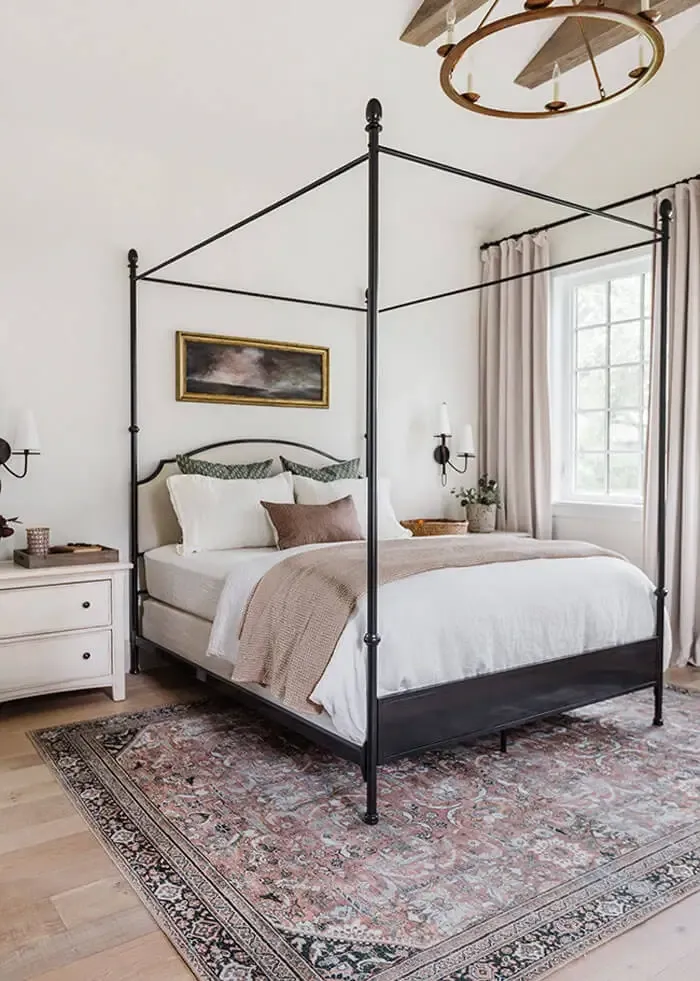
Jenna Sue Design @jennasuedesign
When architectural features or the placement of furniture create an empty framed space, fill it with a piece of artwork like Jenna did in the empty area over her bed. Another idea is to hang prints in the middle of the frame created by decorative millwork.
Choosing the Right Orientation of Art
You should match the orientation of your artwork with the space you are trying to fill. Orientation refers to the way your artwork or photography hang. The image can hang vertically up and down (which is referred to as portrait) or horizontally side to side (which is referred to as landscape).
If your art and wall space don't match in their orientation, you can cheat by using multiple pieces of art.
- On a large horizontal piece of wall, you ideally want a horizontal piece of art work OR two or three vertical pieces hung side by side OR create a gallery wall arranged with multiple pieces of art that spreads across the space.
- On a narrow strip of wall, hang a vertical print in scale to the space or stack two or three horizontal prints on top of each other.
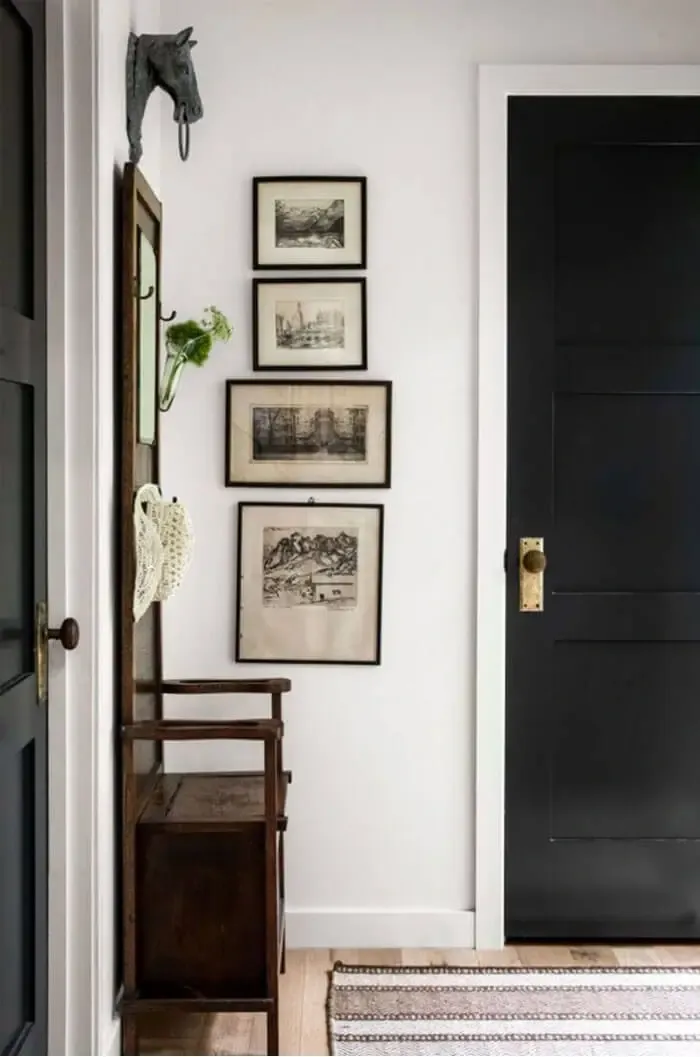
Lauren Liess @laurenliess
When you have a narrow strip of wall like beside a door or between a window and the room's corner, hang a stack of multiple landscape oriented prints like Lauren did in her entryway. This is also a great way to fill in an awkward section of bare wall next to a freestanding cupboard.
Spacing Between Multiple Pieces of Art
When hanging multiple pieces of art or creating a gallery wall, it is a balance between keeping the pieces close enough so that the eye sees them as one unit, yet far enough apart to be appreciated on their own.
- Artwork hung in a grouping should be 3 to 4 inches apart. Groupings are two, three, or more pieces of art hung together, either horizontally, vertically, or in a grid.
- Spacing between artwork in groupings should be consistent. This includes prints forming a grid, displayed vertically, or horizontally all hanging at the same center point.
- When hanging an eclectic gallery wall, spacing does not need to be consistent. Aim for between 2 and 3 inches of space between medium and large frames, and 1 1/2 to 2 inches of space between small pieces. However, you may need to have some closer and others farther away to create a pleasing shape.

Boxwood Avenue @boxwoodavenue
To fill the wall space behind a dresser holding a statement lamp, stack two vintage prints in coordinating frames off to the side of the lamp like Chloe did here. Add a simple vingette in front for a completely styled look.
Hanging Art Over Decorative Wall Treatments
If your walls have decorative moldings or wall treatments like board and batten, you must pay special attention to where the framed piece of art will sit. The trim should either act as a frame around your artwork or be an accent behind it.
- Artwork should be displayed either directly on top of a piece of trim or centered between two vertical pieces.
- Horizontal trim should either run through the middle or top third of the artwork or act as a frame above and below the art.
- If you have vertical shiplap or paneling, try to make sure that the gaps in the wood hang symmetrically behind your print. While not always possible, it is more pleasing to the eye.
- If your woodwork is standard chair-rail height (approximately 32 inches from the floor), art can comfortably hang above it at your standard house height of 57 to 60 inches.
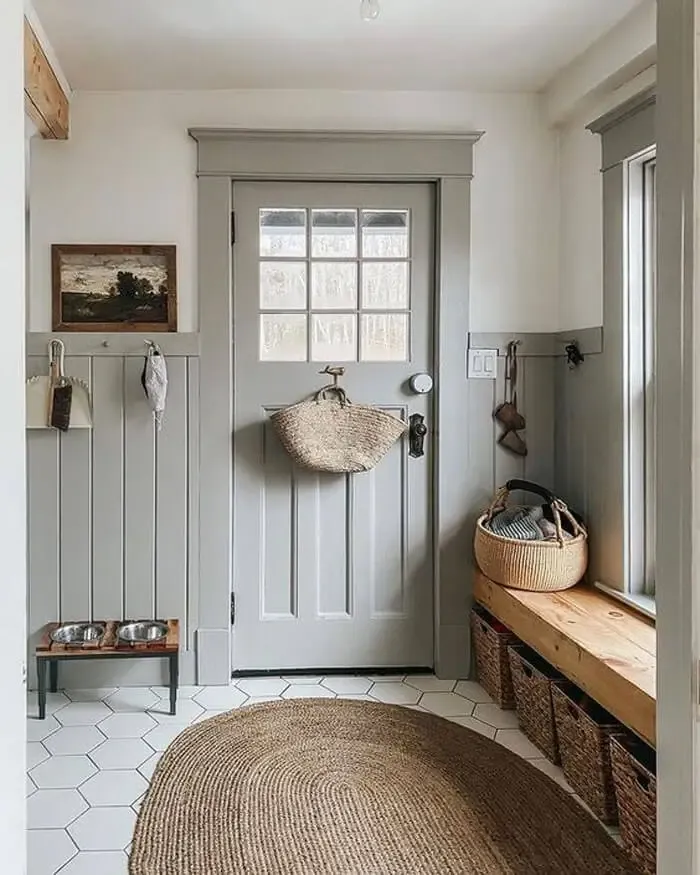
The Wild Decoelis @thewilddecoelis
For those with a wall treatment that extends up two-thirds of the wall topped with a chair rail or ledge, try resting a small piece of artwork on top of the ledge as Katie-Rose did in her mudroom.
For more inspiration from talented designers and bloggers, check out this board filled with over 100 different ways to hang and display artwork throughout the home.
If the thought of hanging artwork makes you nervous or you often feel like the placement of what is on your walls is a bit off, hopefully this article guided you through how to correctly hang art and decor every single time.
CONTINUE READING THESE POSTS IF YOU'RE INTERESTED IN OUR STYLING SECRETS SERIES: A collection of posts teaching you the basics of decorating your home.
Your Guide to Styling a Simple Layered Mantel Vignette
Everything You Must Know About Mixing Throw Pillows

